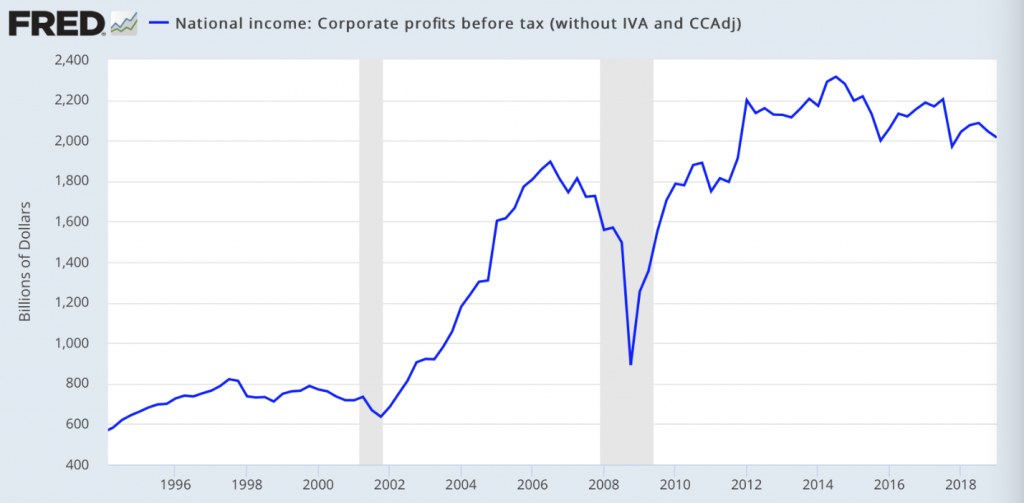Risk: Investors seemingly ignore market conditions… At first blush, the stock market looks to be in an unending rising trend. With slowing global economies, corporate profits before taxes haven’t risen in five years.
What it means – All investment models look back at prior periods to understand new data. Declining profit trends are a precursor of recessions. The declines may be slow or fast, but the result remains constant.

Stock buybacks by a small group of large companies have delayed a major drop in stock indices. Falling profits always reprice stocks downward. Investors need to prepare an exit strategy to avoid another bear market.
The U.S. Declared China a Currency Manipulator… The Chinese government sets the reference rate for its currency, the Yuan. The value of the Yuan dipped below seven per U.S. dollar for the first time since 2008.
What it means – A country can control two out of three currency characteristics – the exchange rate, interest rates, and capital flows. It’s highly unlikely that a government can command all three, and that’s the problem facing the Chinese.
They are suffering through an economic slowdown, which would normally mean capital leaving the country which they don’t want. It would also mean lower interest rates, which they agree with, and a cheaper currency to rebalance the flow of goods with the rest of the world.
By restricting capital flows out of China and holding the currency higher than a market-based exchange rate, the government is essentially holding cash hostage to falling interest rates and dwindling investment opportunities.
The falling Yuan sent shockwaves through the markets, as did the currency manipulator moniker. Investors fear further escalations in the trade war, and more downward pressure on the global economy.
Oddly, China has been manipulating its currency, but not the direction the administration suggests. Chinese officials have held the Yuan higher than it would otherwise be, as evidenced by offshore Yuan trading in Hong Kong, where the Yuan reached 7.10 per dollar.
Oil Prices Drop Almost 10% in Two Days… The price of oil dropped from $55.29 to $50.91 as investors worried about rising supply and weakening economic conditions.
What it means – Oil recovered a bit, climbing over $51 as the Saudi Oil Minister said that OPEC stands ready to do “whatever it takes” to put a floor under oil prices, but investors weren’t too impressed. While OPEC can limit some supply, it can’t control U.S. frackers who are pumping oil with abandon. And at some point, OPEC members will rebel and break their quotas because they need the money.
Unless we get clear signs that the global economy will turn around soon, expect oil prices to remain under pressure throughout 2019.
Gold Surges Above $1,500… The precious metal jumped from a little above $1,400 to $1,500 over the past 10 days as investors worry about currency wars.
What it means – The Fed cut rates, the European Central Bank hinted that rates are headed into even deeper negative territory. The Bank of Japan is considering more stimulative action. All of this in addition to China’s making the Yuan a bit cheaper. No government official claims to be in a currency war where the goal is to be cheaper than your neighbors, but investors know one when they see one.
With more than $14 trillion in global bonds trading at negative interest rates, and rates falling around the world, investors holding cash are getting smacked. The alternatives are bonds, which offer precious little interest, equities, which are near record highs, and commodities, where one shines brighter than all others. People are turning to gold as a storehouse of value while their political leaders take aim at their own currency.
The next move in gold depends on the global economy. If things stabilize, then gold might lose a little luster, but if we fall into a recession, then we could take out the high established in 2011.

